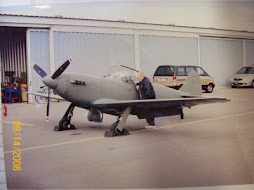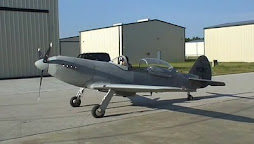On Saturday, June 16th, 2018 Ernest ("EZ") went out about noon from the Tacoma, WA airport (KTIW) to do his "Second 1st flight" in his Prowler. (This aircraft was kit #5, the silver and black airplane and the 3rd Prowler that George built). The flight went great for about 7-8 minutes, right up until the engine
suffered a failure that caused a loss of engine oil pressure. With little to no
oil pressure, the props hit the low-pitch stops which caused the prop to over-speed and the engine began to come apart. The flight terminated in a forced, off-field landing on a beach at the north end of the McNeil Island - southwest of Tacoma Narrows. Here are some pics of where airplane came to rest:
Thankfully, EZ walked away uninjured, but the plane is a total loss (due to sea water intrusion). He landed on a narrow strip of beach created at low tide and the plane was completely submerged in salt water at each high tide for about 4 days. EZ did an amazing job getting his airplane on the ground! He essentially had 3 options for landing - into 200 ft trees on McNeil Island, in the water (Carr Inlet), or the beach that he ended up landing on. Incredible job, EZ!! We are all so very, very thankful that you were not injured during this forced landing!
I am ultimately frustrated, sickened and dismayed for EZ - because I worked closely with him to help him and support him while he got the airplane put back together after a previous forced landing in the airplane. I know first-hand the effort, energy and expense that he put into rebuilding the airplane. I went to see him and the plane a couple of times and we talked on the phone frequently solving issues and working out solutions. He and his mechanic, Dave, did a great job! He did 20+ hours of engine runs including high speed taxi runs to prepare for this flight. They did all the right things, as near as I can tell. He was so excited about getting the airplane back into the air. It's so sad!! As I stated earlier, though, I'm just so happy that he did such a great job getting the airplane down and was not injured!! The airplane can be replaced, but he cannot!! [In fact, the airplane has already been replaced with a Van's RV-8.]
Ultimately, the incident did not meet the requirements of NTSB 830.2 definition of "substantial damage." That means the NTSB did not have to do an investigation and the FAA asked a few questions and filled out a few reports. No other actions were taken.
The insurance company hired a salvage company and arranged to have the aircraft extracted from the beach so that a causal inspection could be completed:
The causal inspection revealed that the engine (somehow) shed two crankshaft main journal bearings. When these bearings came out the engine oil gallery was uncovered and resulted in significant loss of oil pressure. Based on this, the insurance company paid EZ for his loss.
[Sidebar
note: This is, at least, the 2nd event that I am aware of where the
loss of engine oil pressure has caused the loss of prop control and a
prop over-speed. Based on this, I will be coming out with a
recommendation that anyone using George's Autoaviation engine setup add a
separate, dedicated oil supply system to provide backup oil pressure to
the prop governor pump. This will require a separate oil line off of
the oil sump and require adding a separate dedicated electric oil boost
pump with a regulator/pressure relief to supply pressure directly to the
prop governor in case the engine oil system pressure drops. I will be
reaching out directly to each of the owners of George's Autoaviation
engines in the near future to get ideas for this system and I will share
it with everyone when we determine the most simple, safe and reliable
backup system. By doing this, in theory, a loss of engine oil pressure
will not necessarily lead directly to a loss of prop control. As long
as there is still oil in the sump, the prop will still be controllable. More to follow on this. ]
Also, the landing on the soft silt on beach tore the left main gear strut out of the strut saddle/clamp:
However, believe it, or not, were it not for the sea water damage to the aircraft, the plane could have (fairly easily) been rebuilt! The main spar had no damage. The airframe was not bent at all. I took measurements several ways to the tail from reference points on the main spar - and everything was symmetric. So, while it is true that the propulsion system suffered a serious failure, the airframe is solid. Granted, the hard landing took its toll on the MLG systems, but the spar was not damaged and the airframe is still straight as an arrow! This is good testament to the fact that George created a very robust design for the airframe of the Prowler.
During his dealings with his insurance adjuster, EZ was also instrumental in helping to arrange for me to make an offer to the insurance company to buy the hull. Since the insurance company was simply going to scrap the aircraft, I just couldn't let George's 3rd Prowler get melted down! Thankfully, the insurance company accepted my offer and I drove up to Tacoma in early Sep to get the airplane. Here is the airplane on a trailer that was used to get it from the salvage company and to the hangar it was in to perform the causal inspection:
Here is the plane after we got it lifted off of the other trailer and set onto George's old trailer (EZ was letting me use George's trailer to get it back to my shop):
Here is the airplane on George's trailer all tied down and ready to head back down to my shop:
And, here is the truck and airplane the next morning at 730am when I pulled back into my driveway:
The plane and the trailer pulled great the entire way! The next day, I took the engine off the plane to make it lighter and easier for me to get off of the trailer by myself. Here is the plane just prior to removing the engine:
The day after removing the engine, I was able to get the airplane off of the trailer and placed on stands in my front yard. First, I got it off the trailer using an engine hoist on one wing and my tractor on the other:Then, I got it set down onto two aircraft jacks and one tail stand:
So, for now, N611GM will be "yard art" in my front yard between the pump house and a tree. Eventually, I plan to remove as many panels as possible and rinse the airplane out as best as I can to get the sea salt and sea weed out of it. Then, I'm going to hammer out the dents and fix the plane up so that it looks good from a distance. My goal (for now) is to make it a static display that looks good from 20-30 feet. Maybe, someday, it will be my Prowler Aviation billboard!?!?



























